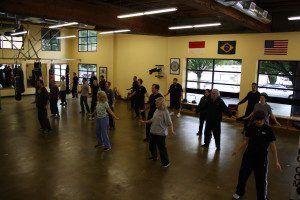From the Raise Arms position – The drive for all Yang Style tai chi movements starts and ends in the Tan Tien. If the center isn’t moving the body shouldn’t be either.

Portland Tai Chi Class
While you are turning back to the front the weight is smoothly shifting into the right foot. The heel of the left foot comes off of the ground and pivots in. The toe of the left foot stays resting lightly in the same spot.Turn the waist slowly to the left, about 45 degrees. As you do so the left hand slowly sinks until it reaches approximately hip height with the palm facing down. Slowly, turning from the Tan Tien, come back to facing forward. The left hand is circling in as you turn until it is palm up just beneath the navel. The right arm is gradually bending in at the elbow until it finishes with the right palm facing down, over the the left hand, at the height of your collarbones.
At the end of this Yang Style tai chi movement check to be sure your shoulders are relaxed down. Your right elbow should be sunk below the height of the right hand. The hands should be two fists width out in front of the body.
Previous Yang Style tai chi movement: Raise Arms
Next Yang Style tai chi movement: Parting the Wild Horse’s Mane
Yang Style Tai Chi Philosophy:
Hold the Ball in T-stance Position – Gather in and hold everything in your life that is precious to you. (Traditionally this would be family, friends and teachers.) Hold lightly and appreciate what you have.
Martial Application:
Joint Lock – Seize the opponent’s wrist from the outside (your fingers wrap around the inside of their wrist) after deflecting a strike, push, etc. Use your opposite hand to press their controlled hand down an in toward the body using your fingers as the fulcrum. You hands are now in a small “hold-the-ball” position. Roll that ball to leverage the opponent’s joint into a submission.
Every Tai Chi movement is said to have between three and thirty applications. The application listed is one example of how to effectively apply the movement.
Alternate Translations:
Parting the Wild Horse’s Mane (Ye Ma Fen Zong)
Wild Horse Waves Its Mane [Zhang Fuxing]
Parting a Wild Horse’s Mane (Zuo You Ye Ma Fen Zong) [Foen Tjoeng Lie]
Wild Horse Parts Its Mane [Chong]
Parting the Horse’s Mane [Metzger & Zhou]
Wild Horse Shakes Its Mane
This information is meant for reference and to give an idea of the details involved in all Yang Style tai chi movements. In order to receive the benefits of an internal arts practice it is vital that you seek qualified instruction.
If you are in the Portland, OR area and would like to know more about learning Yang Style tai chi. Contact us here.
If you are outside of Portland and would like information about our seminars or becoming and instructor please visit this page: Martial Arts Seminars & Instructorships



